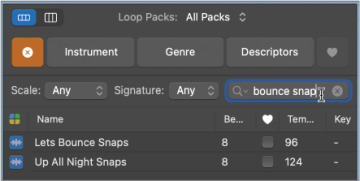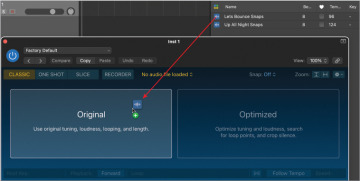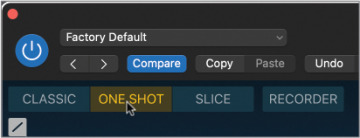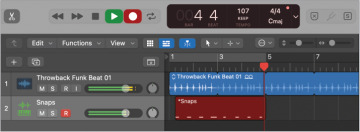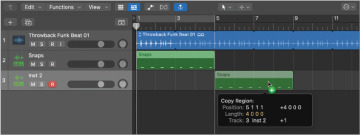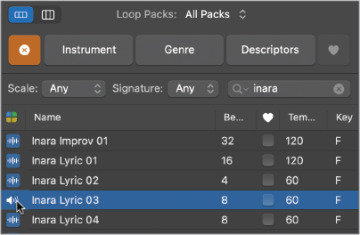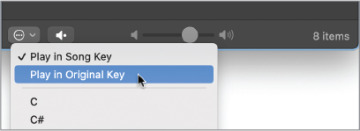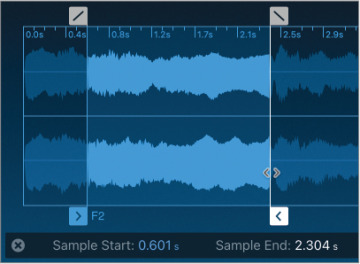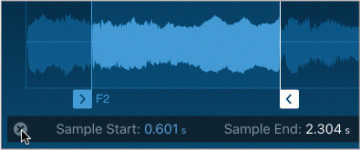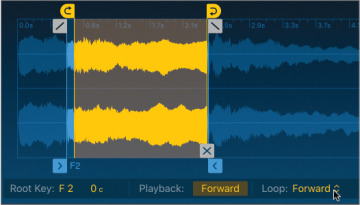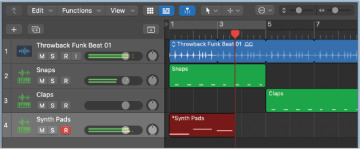Sampling Audio
This chapter on Logic Pro helps you get started in music production and sound engineering, by sampling audio from vocal recordings and audio files.
Shortly after the first analog tape recorders appeared around 1935, composers started using the recording medium as a compositional tool—manipulating the audio playback using reverberation and echo; using voltage control devices that changed the tape speed and thus altered playback speed and pitch; and using punch recording to splice different sounds together. Throughout the following decades, electroacoustic composers—and later pioneering electronic musicians—fascinated by the new unique sounds they could come up with, continued exploring audio transformation techniques involving recording devices to stray away from the classic acoustic instrument sounds of composers from past centuries.
In 1988, Roger Linn designed the AKAI MPC60, which quickly became the most legendary sampler and had a major impact on hip-hop music. The iconic MIDI sampler made it easy to trigger samples by finger drumming on its built-in square pads, while recording the performance onto its built-in sequencer. Today, you would be hard-pressed to find a music genre where sampling isn’t used.
In this lesson, you’ll explore Quick Sampler, a new Logic Pro software instrument plug-in. You’ll import a handclap, record a sample, and then turn a sustained vocal note into a pad synthesizer sound. You’ll slice a drum loop, shortening the volume envelope of the individual slices, and add a gritty filter to give it a low-fidelity sound. You’ll splice loops together to combine notes from different instruments into a composite melody, creating an exhilarating rhythmic sound collage. Finally, you’ll edit samples into an effect called vocal chops.
Always consider the source of your sampling, and if any of that material is copyrighted, make sure you thoroughly research sample clearance. Two easy ways to avoid worrying about potential legal issues are to sample your own instruments or noises around you, or to sample the royalty-free Apple Sound Library content that you downloaded along with Logic Pro (such as software instruments or Apple Loops).
Sampling Single Notes
The easiest way to use samples in your productions is to import or record a single note into Quick Sampler, and then trigger that single note from your MIDI keyboard. In Quick Sampler, you can modulate the sample’s pitch to give it a vibrato effect, adjust the volume envelope, and loop a section of the sample so that you can sustain its sound.
Importing Audio in Quick Sampler and Selecting a Mode
In this exercise, you’ll use an Apple Loop of finger snaps to create a Quick Sampler instrument so that you can trigger the audio file using your MIDI controller keyboard. To get started with a rhythmic reference, you’ll first import a loop to create a drum track.
Choose File > New (or press Shift-Command-N).
An empty project is created, and the New Track dialog opens.
In the New Track dialog, select Audio, and click Create (or press Return).
Open the Loop Browser, find Throwback Funk Beat 01, and drag it to the audio track at bar 1.
In the Region inspector, click the Loop checkbox (or press L).
In the workspace, the audio region is looped throughout the project. Now let’s create a new track for Quick Sampler.
At the top of the track headers, click the + button (or press Command-Option-N).
In the New Track dialog, choose Software Instrument, make sure the Instrument pop-up menu is set to Empty Channel Strip, and click Create (or press Return).
Click the Instrument slot, and choose Quick Sampler (Single Sample).
In the Loop Browser, search for bounce snap.
Drag Lets Bounce Snaps to the waveform display in Quick Sampler.
In the waveform display, two areas appear (Original and Optimized).
Drop the file onto Original.
The audio file is imported into Quick Sampler, and its waveform is displayed. Below the waveform display on the left, the root key is C3.
Play a C3 on your keyboard.
In Classic mode, the sample plays back while you hold down the key on your keyboard and stops playing when you release the key. Play a C3, and hold down the key for a while. The audio file starts with silence and contains finger snaps and handclaps. To turn it into a playable instrument, in the next exercise you’ll adjust the start and end markers so that a C3 note immediately triggers only the last handclap.
Play notes other than C3 on your keyboard.
The sample is transposed chromatically across the keyboard, according to the pitch of the note you play. Higher pitches make the sample play back faster, and lower pitches make it play back slower, much like classic samplers, and also like the results you’d get from manipulating the speed of analog tape or a turntable. You’ll change that behavior for other samples later. For this finger snap sample, you’ll play only C3 notes to trigger the sample at its original speed and pitch.
To avoid having to hold down the key for the whole duration of the sample, you’ll use the One Shot mode.
Click One Shot.
Play a C3.
In One Shot mode, the sample plays back from the start marker to the end marker, even if you release the key earlier. This mode is adapted for drum sounds, because you can trigger drum hits with pads or drum controllers that send very short notes, and still play the full duration of the drum sample.
You have created your first sampler instrument with a finger snap sample and selected the One Shot mode. You are now ready to start editing the portion of the sample you want to play back in the waveform display.
Editing Markers in the Waveform Display
When editing a drum sample, it’s crucial to make sure the sample starts playing exactly when you trigger it. You’ll now use the waveform display in Quick Sampler to precisely adjust the start and end marker locations, making sure only the fourth finger snap on the waveform is triggered. Don’t worry about finding the perfect position right away. You’ll later zoom in to readjust the start marker position with more precision.
In the waveform display, drag the start marker to beginning of the last handclap.
Below the waveform display, parameters and values related to the current action are displayed.
Play a C3.
This time only the last handclap plays.
Drag the end marker a little closer to the end of the waveform.
You’ll now zoom in on the waveform between the start and end marker.
At the upper right of the waveform display, click the Zoom horizontal button.
The zoom level is optimized to show the area between the sample start and end markers. To help position the start marker exactly at the beginning of the handclap sound, you can make the markers snap to transients.
At the upper right of the waveform display, click the Snap pop-up menu, and choose Transient+Note.
Drag the start marker toward the beginning of the waveform.
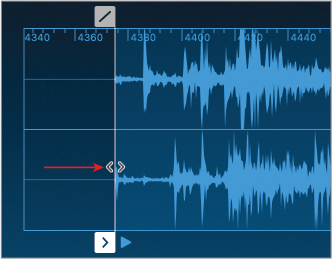
The start marker snaps precisely to the first transient on the waveform.
Play a C3.
The sample is triggered right away. Your sampler instrument is now ready to be played.
Adjusting the positions of sample start and end markers lets you determine exactly which portion of an audio file you want to trigger when playing your keyboard, and it represents the foundation of creating a quality sampler instrument. Using Quick Sampler’s zoom and snap functions, you were able to get the job done efficiently and can now focus on the performance.
Recording a MIDI Region to Trigger Samples
You’ll now put the recording chops you acquired in the previous lesson to good use and record a very simple handclap performance. You’ll play a finger snap on the second and fourth beat of each bar throughout the first five bars of this project to double the snare in the drum loop on Track 1. Let’s open the Piano Roll to see the notes you record.
In the control bar, click the Editors button (or press P) to open the Piano Roll.

Regions recorded on a track are assigned the track name, so it’s always a good idea to give your track a descriptive name before you start recording.
In the Inst 1 track header, double-click the track name, and then enter Snaps.
When using only Apple Loops and MIDI regions, as is the case so far in this project, don’t hesitate to lower the tempo as needed to make it easier to perform what you’re recording.
In the LCD display, lower the tempo down to 107 bpm.

In the control bar, click the Record button (or press R).
You get a four-beat metronome count-in, the playhead reaches bar 1, and the drum loop starts playing back.
Play a C3 on beats 2 and 4 of every bar until the playhead reaches bar 5.
In the control bar, click the Stop button (or press the Space bar).
Recording stops, and you have a four-bar green MIDI region on the Inst 1 track. To make the rhythm track, you’ll quantize your recording. If you’re unhappy with your performance, choose Edit > Undo Recording (or press Command-Z), and try again!
In the Region inspector, click the Quantize pop-up menu, and choose 1/4 Note.
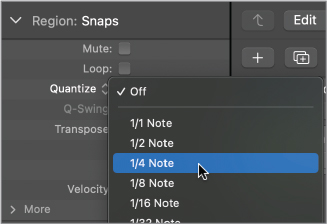
In the Piano Roll, the notes snap to the nearest beat.
Listen to your recording.
The handclaps double the snare drum, bringing energy and a human character to the beat.
Modulating the Sample’s Pitch
To make the snaps a bit more human sounding, you’ll now modulate their pitch. In Quick Sampler, you’ll use a low-frequency oscillator (LFO) to generate a random signal and route it to the pitch parameter so that each note triggers the finger snaps sample at a slightly different pitch.
Now that you have a MIDI region on the Snaps track to trigger your samples, you can click the play button in the Piano Roll to cycle through the MIDI region in Solo mode, allowing you to give your full attention to the sample’s sound while you adjust the parameters in Quick Sampler.
In the Piano Roll, click the Play button.
Cycle mode and Solo mode are on, and the MIDI region plays back. In Quick Sampler, you’ll route LFO 1 to the pitch.
In the lower section of Quick Sampler, click the Mod Matrix tab.
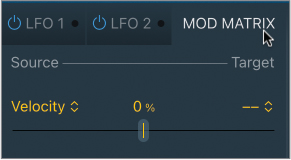
The Mod Matrix opens, and you can assign up to four routings. You could choose a controller, such as the modulation wheel as the source and the pitch as a target, to control the pitch with your modulation wheel. However, in order to create an automatic random pitch modulation, you’ll route an LFO to the pitch, and then set the LFO to produce a random control signal.
On the first matrix, click the Source pop-up menu and choose LFO 1.
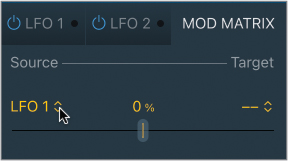
Click the Target pop-up menu and choose Pitch.
To clearly hear the modulation you’re routing, you can exaggerate the amount of modulation for now. Once you are satisfied that you’ve successfully set up your modulation routing and are getting the desired effect, you can dial the Amount slider back down to a more reasonable value.
Drag the Amount slider all the way up to 1200 cents.
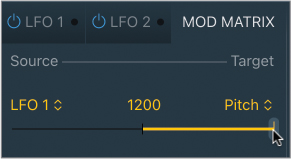
In the Pitch section, an orange ring appears around the Coarse knob that represents the modulation range. A white dot shows the current value for the Coarse knob, determined by the value sent by LFO 1. Let’s make sure LFO 1 generates a random signal.
Click the LFO 1 tab.
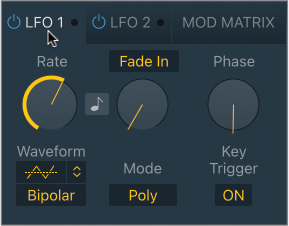
Click the Waveform pop-up menu, and choose Random.
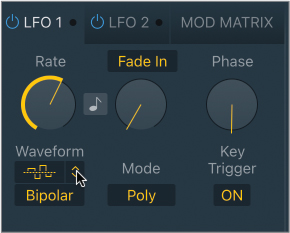
Each finger snap is triggered at a random pitch within a wide range of pitch modulation. Let’s now bring that range to a more subtle value.
Click the Mod Matrix tab.
In the LFO 1 to Pitch assignment, drag the Amount slider down to around 135 cents.
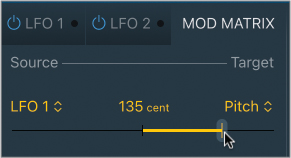
The pitch modulation is quite subtle now, making each finger snap slightly different sounding than the previous one.
Close the Quick Sampler plug-in window.
Stop playback.
You’ve assigned a low-frequency oscillator with a random waveform to modulate the pitch of the sampler in subtle amounts. That pitch randomization is just enough to make the sampled finger snaps sound a bit more human.
Recording Audio in Quick Sampler
You’ll now create a new software instrument track and record your own handclap sample directly into Quick Sampler. You’ll then copy the MIDI region you recorded for your finger snaps to the new track so that you can trigger your handclap sample using the same note sequence. For this exercise, you’ll need to make sure the correct input device is selected in Logic’s audio preferences, the same way you did in Lesson 4.
At the top of the track headers, click the + button (or press Option-Command-N) and create a new software instrument track.
In the instrument slot, insert Quick Sampler.
Above the waveform display, click the Recorder button.
A Record button appears in the middle of the waveform display. To the lower left of the waveform display, make sure the input where you’ve connected your microphone is selected from the Input pop-up menu. To use your Mac computer’s built-in microphone, use Input 1.
Below the waveform display, the Record Start pop-up menu is set to Threshold. After you click the record button on the waveform display, Quick Sampler waits for the audio signal at the selected input to reach the threshold set by the slider on the Level Meter slider.
Clap your hands a few times and, if needed, adjust the Level Meter slider.
Watch the Level Meter. The input signal level should reach above the Level Meter slider position when you clap your hands. Make sure the peak value displayed to the right of the Level Meter does not turn red, which would indicate you’re clipping the signal. If needed, adjust the input gain on your audio interface.
In the waveform display, click the Record button.
Quick Sampler is waiting for the input level to reach the threshold set by the Level Meter slider to start recording.
Clap your hands once.
If all went well, you can see a waveform for your handclap, and the peak detector to the right of the Level Meter does not go red. If your clap wasn’t loud enough, the recording doesn’t start, and you can clap again, louder this time. If your clap was too loud, the peak detector turns red; you can click the peak detector to reset it, click the stop button in the waveform display, and try again.
In the waveform display, click the Stop button.
The recording stops, and your sample is ready to be triggered.
Above the waveform display, click the One Shot button.
Since Quick Sampler started recording exactly when you clapped your hands, the start marker is at the right position.
Drag the end marker toward the end of your clap sample.
In the Tracks view, Option-drag the MIDI region from the Snaps track to the Claps track at bar 5.
Let’s rename the new Quick Sampler track and region.
On the Inst 2 track (Track 3), double-click the name, and enter Claps.
In the Tracks view menu bar, choose Functions > Name Regions/Cells by Track Name (or press Option-Shift-N).
The selected region on the Claps track is renamed Claps.
Listen to your claps.
Close the Quick Sampler plug-in window.
Don’t hesitate to use the volume sliders in the track headers to readjust the balance between the drum loop on Track 1 and the Snaps and Claps tracks.
Handclaps are easy and fun to record. If you’re not alone, try sampling a group of people clapping together. Don’t limit yourself to finger snaps and handclaps. When Trevor Horn recorded the 1980s hit song “Relax” by Frankie Goes to Hollywood, he recorded the whole band jumping into the pool, and you can hear the resulting samples play toward the end of the song. Just look around you, and experiment with whatever inspires you. Try stomping on plastic cups, punching cardboard boxes, shredding paper, and so on. All these sound effect samples can add great texture to your beats.
Creating a Quick Sampler Track Using Drag and Drop
For the intro, you’ll turn a vocal recording into a pad synthesizer instrument so that you can play melodies or chords with your keyboard. This time you’ll speed up the process of importing an audio file in Quick Sampler by using the shortcuts that appear when dragging an audio file directly to the empty space below the track headers.
In the Loop Browser, search for inara.
Preview Inara Lyric 03.
The loop’s key is F; however, it’s currently previewed in the project key (C). It sounds unnaturally low.
In the Loop Browser, click the action menu at the bottom left, and choose Play in Original Key.
Inara’s vocals sound more natural. Let’s import that loop into Quick Sampler.
Drag Inara Lyric 03 to the empty area below the track headers, and in the menu that opens, choose Quick Sampler (original).
A new software instrument track is created with Quick Sampler in the instrument slot. Quick Sampler opens, and the audio file you dragged is imported in Quick Sampler. Quick Sampler recognized multiple notes in the audio file and determined it was appropriate to use Slice mode; however, you’ll switch to a Classic mode in the next exercise to play a single-note sample.
Dragging audio files from the browsers, the workspace, or the Finder to the empty area below the track headers saves you the tedious work of creating a new track and inserting the Quick Sampler plug-in every time you want to experiment with sampling something.
Looping Sample Playback to Sustain Sound
When sampling material that you want to turn into a software instrument to play melodies or chords, you can loop a section of the sample. A sample loop keeps repeating until you release the key, allowing you to sustain the sample as long as you want.
To loop samples in Quick Sampler, you must choose Classic mode.
In Quick Sampler, click the Classic button.
To the lower right of the waveform display, the root key is F2.
Play an F2 note, and then play different notes on your keyboard.
The entire vocal sample plays back, transposed according to the note you play. You’ll adjust the start and end markers so that a single note plays back.
Drag the start marker to the beginning of the second note in the sample (around 0.600 s).
Drag the end marker to the end of the same note (around 2.300 s).
Play a note.
Now only the note between the start and end markers plays. If you continue holding down a key, the note still stops when the Quick Sampler playhead reaches the end marker. Let’s create a loop section. Since you adjusted marker positions, the parameter display bar below the waveform display is hiding the Loop mode pop-up menu, so let’s close it.
You may notice that the section of the sample you chose to trigger is actually not an F note. You’ll later tune your instrument to make sure it plays the correct pitches.
Below the waveform display, click the X to the left of the parameter display bar.
The parameters revert to the default view, and you can see the Loop parameter.
Click the Loop mode pop-up menu, and choose Forward.
In the waveform display, yellow loop start and end markers let you set the loop boundaries. The loop section between the loop markers is yellow.
At the upper left of the waveform display, click the Zoom horizontal button.
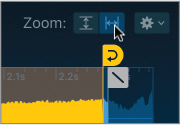
Adjust the loop start and end markers.
Continue playing an F2 note while you adjust parameters in Quick Sampler. The goal is to have the loop sound as seamless as possible. Unless you’re very lucky, you’re hearing a popping sound as the playhead skips from the loop end marker to the loop start marker. There are a few tools in Quick Sampler that can help that situation.
First, you can snap your markers to zero crossings, positions where the waveform crosses the horizontal zero line in the middle of the waveform.
Click the Snap pop-up menu, and choose Zero Crossing.
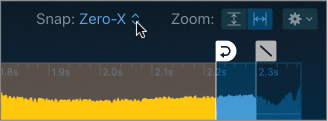
Continue adjusting the loop markers. You should hear less of a popping sound. To make the loop sound even smoother, you can use the Alternate loop mode, which plays the loop alternately from the loop start marker to the loop end marker, and then from the loop end marker to the loop start marker.
Click the X to the left of the parameter display bar to see the default parameters. Click the Loop mode pop-up menu, and then choose Alternate.
Playback no longer jumps from the loop end marker to the loop start marker, making the loop more even. You can probably still hear clicks at the loop start and end markers, but for now, try to focus on having the pitch and amplitude of the note sound fairly continuous. Once you’re happy with your loop section, you can further polish the loop using a crossfade at the loop start and end markers.
Drag the crossfade marker to the left to create a crossfade at the loop start and end points.
Adjust the length of the crossfade so that the popping sound disappears and the loop sounds smooth. You may need to readjust your loop start and end marker positions.
Finding the right position for a sample loop can take finessing and experimentation, so take your time and keep trying.
Play and sustain a chord on your keyboard.
This sampler instrument still retains the original timbre of Inara’s voice, but now you can play it like a synthesizer on your keyboard.
Finding the best positions in an audio file for your sample start, sample end, loop start, and loop end markers is the foundation of good sampling. Ultimately, not all audio files will give you good-sounding results when looped. As you acquire more experience, you’ll get better at recognizing parts of recordings that will work when sampled by listening but also by looking at the waveform, and you’ll get faster at editing the samples.
Modulating Samples with LFOs and Envelopes
Now that you’ve turned audio material into a sampler instrument, you can use the modulation section in the lower section of the Quick Sampler interface to affect different playback parameters. You’ll adjust the amp envelope to give your vocal a soft, slow attack and a long release, turning the instrument into a synthesizer pad. You’ll then record long sustained chords to lay down the background harmony while adding texture. Then you’ll modulate the pitch of the samples to create a vibrato effect.
At the bottom of the Amp section, the envelope display lets you control how the level changes over time when a sample is triggered. The selected envelope type, ADSR, stands for Attack, Decay, Sustain, and Release—the four segments that determine the shape of the envelope.
At the bottom of the Amp section, move the pointer over the Attack handle (the first point in the envelope display).
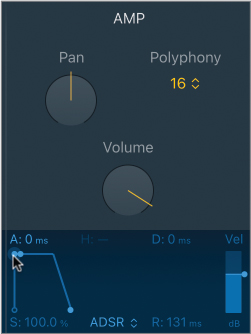
The Attack field (A) is highlighted.
Drag the point toward the right.
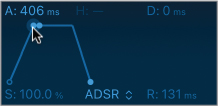
To check your work, keep playing an F2 note after adjusting parameters in Quick Sampler. The Attack segment is slopped, and the samples fade in slowly rather than starting abruptly. Try different attack lengths, and finally settle for around 400 ms.
At the lower right of the envelope shape, drag the Release handle to set the release to around 600 ms.
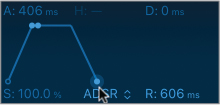
The sound takes 600 ms to fade out when you release keys on your keyboard, almost like the sound of a reverb tail. This soft envelope is great for a pad sound. Let’s dial in a vibrato effect.
Click the Mod Matrix tab.
On the first routing, click the Source pop-up menu, and choose LFO 1.
Click the Target pop-up menu, and choose Pitch.
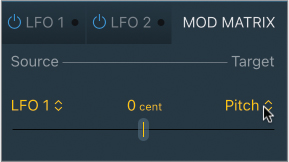
Drag the Amount slider to around 500 cents.
In the Pitch section, note the orange ring around the Coarse knob, representing the range of pitch modulation applied by your routing.
Play a few notes on your keyboard.
You can hear a very wide pitch range vibrato—it sounds like a siren! A white dot moves around the Pitch knob to indicate the pitch in real time. Let’s dial in a more reasonable pitch range.
In Mod Matrix, drag the Amount slider to 50 cents.

That is still a fair amount of vibrato. When you listen to and observe classical string players, they often attack a note with a constant pitch at first, and start applying vibrato with an increasing pitch range as the note is sustained. To reproduce this effect, you’ll apply a delay to LFO 1.
Click the LFO 1 tab.
Drag the Fade In knob to around 2500 ms.
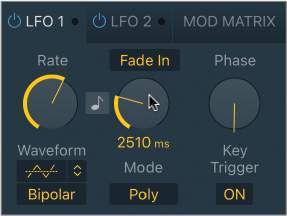
Before you start recording, you need to tune the instrument. When you play an F2, you hear a G2 instead, so let’s fix that.
At the lower left of the waveform display, set the root key to G2.
Let’s rename the track and record some chords.
On the Inara Lyric 03 track header, double-click the name, and enter Synth Pads.
Record one-bar long notes or chords from bar 1 to bar 5 to lay down a harmony in the intro section.
You are just experimenting for now, so feel free to play any notes you want. However, if you can, keep all melodies and chords you record in this lesson in the key of C minor, and you’ll later be able to arrange all your tracks together into a cohesive song.
If needed, use the Quantize pop-up menu in the Region inspector to correct the timing of your performance. If some of the notes need to be edited, open the Piano Roll to drag the notes to the desired position or pitch. Don’t hesitate to readjust Quick Sampler settings to your tasting, adjusting the attack or release of the Amp envelope, and the amount or delay of vibrato. In the inspector, feel free to add audio effect plug-ins to the Synth Pads channel strips.
Close the Quick Sampler plug-in window.
You have explored several methods for sampling single notes. You have imported a finger snap audio file, recorded your own handclaps, and sampled a vocal note to turn it into a new software instrument. In the process, you’ve gained familiarity with Quick Sampler—using the Mod Matrix to route LFO to pitch, adjusting the Amp envelope, adjusting sample start and end markers, and creating a loop and making sure it cycles smoothly.

